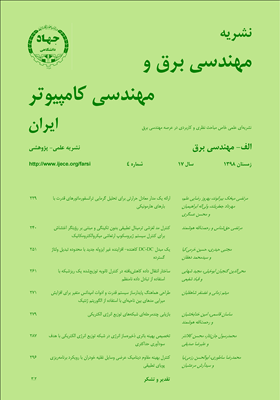یک مبدل DC-DC کاهنده- افزاینده غیر ایزوله جدید با محدوده تبدیل ولتاژ گسترده
محورهای موضوعی : مهندسی برق و کامپیوترمجتبی حیدری 1 , حسین خرمیکیا 2 , سید محمد دهقان 3
1 - دانشگاه صنعتی قم
2 - دانشگاه صنعتی اصفهان
3 - دانشگاه صنعتی قم
کلید واژه: مبدل DC-DC کاهنده- افزاینده غیر ایزولهمبدل DC-DC با محدوده تبدیل ولتاژ گسترده (WIWO)بهره ولتاژ بالا,
چکیده مقاله :
در این مقاله یک مبدل DC-DC غیر ایزوله کاهنده- افزاینده جدید با محدوده گسترده ولتاژ ورودی و ولتاژ خروجی پیشنهاد میشود. مبدل پیشنهادی دارای جریان ورودی پیوسته بوده و قابلیت افزایش و کاهش ولتاژ ورودی را در دوره کاری پایینتری از سوییچ قدرت نسبت به مبدلهای کاهنده- افزاینده غیر ایزوله مرسوم فراهم میکند. این موضوع باعث کاهش ریپل جریان سلفها و کاهش تلفات هدایت و افزایش بازده کلی آن میشود. ساختار مدار پیشنهادی و سیستم کنترل آن ساده بوده و همچنین سوییچهای مورد استفاده به صورت همزمان با یکدیگر روشن و خاموش میشوند. در این مقاله تحلیل حالت ماندگار مبدل پیشنهادی در مد CCM ارائه میشود. نتایج شبیهسازی و آزمایشگاهی صحت عملکرد مبدل پیشنهادی و تحلیلهای تئوری را تأیید میکند.
In this paper, a new wide-input-wide-output non-isolated buck-boost DC-DC converter is presented. The proposed converter has continuous current and is able to buck and boost the input voltage with shorter duty-cycles of the power switch compared to conventional buck-boost converters. A smaller duty cycle for a given voltage gain translates to lower current ripple of the inductors, reduced conduction losses, alleviated voltage stresses of the semiconductor switches and improved overall efficiency. The proposed converter also benefits from a simpler structure and control scheme. In this paper, the steady state operation of the proposed converter is investigated under both continuous conduction mode (CCM). The simulation and experimental results confirm the validity of theoretical analysis as well as the proper performance of the proposed converter.


